How to Winterize My Horse Barn?
Winter brings cold temperatures, wind, snow, ice, and all things that will undoubtedly affect your horses, their containment wellbeing, and you. Just as your car and home have special cold weather considerations, so do the equine-related items in your life.
Don't be left in the "cold" with endless projects when the snow starts flying. Organize your horse barn now and complete your winter projects so you are prepared to handle any inclement weather – no matter when it hits!
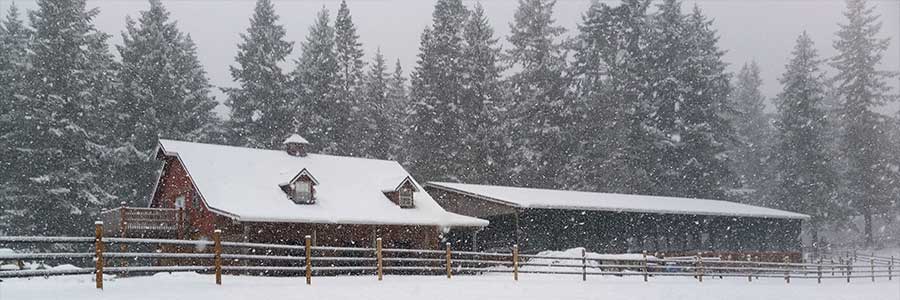
1. Horse Stall Safety & Cleanliness
Your horse may live in its stall 50% of the time, if not longer. A horse's stall should be a safe place [home] that provides comfort, a sense of security, and easy feeding.
- Stall Safety – Horses usually spend more time indoors during colder months, so do a good check of each stall for splinters, broken boards, loose nails, etc. that could result in an injury.
- Feeder Safety – Make sure hayracks and feed pans are secure. Cheap, plastic feed bins may crack in the cold; watch for sharp edges and replace if necessary.
- Holes – Holes in horse stall walls or any open spaces can turn into a place for a potential injury from a kick or a curious nose.
- Lumber Replacement – Replace any old wood and be sure your stalls are free from any split, chewed, and uneven boards.
- Splinters – While your horse may be spending more time indoors in the colder months, make sure his stall or shelter has no splintered boards or loose nails. Splinters may not be noticeable to the eye, so run your hand carefully over the walls. Your hands may find something your eyes didn't.
- Maximizing Areas for Manure Disposal – Be sure that when you clean your stalls you have the easiest path to and from your manure pile, bunker, compost, or wherever you dispose of used bedding. Whatever your means is for cleaning (tractor and spreader, 4-wheeler with a bed that dumps, or even a wheelbarrow) think about your path when snow is on the ground and take precautionary measures [now] to make your path easier and safer to use. Spreading small stones on a path helps with traction and filling low ruts on the ground will help to avoid places where you could get potentially stuck.
- Bedding Preparations and Storage – Now is also a good time to decide what bedding you will need through the winter months. Make sure that there is enough bedding down to keep your horse from lying directly on the floor. While stall mats will help insulate the floor, don't cut back on bedding. Bedding provides warmth, but absorbs urine; make sure to keep stalls picked out.
- Avoiding Moisture – Some people pour a concrete pad, use a wood floor, or some other means of keeping moisture from getting to the bottom of the bedding. Consider using a tarp or cover to keep the bedding dry if your storage area is outside of your barn.
- Buying in Bulk – Towards the end of the summer season, you can pre-plan, save money, and have your hay ready for winter. Check on prices for large round hay bales; early purchasing will prove to give you better hay prices rather than waiting until after the first of the year when prices can double. Always use caution when getting bulk shavings to be sure it does not contain wood from nut or fruit-bearing trees, which can be toxic to horses.
- Storage – If you're using sawdust or shavings, decide where you will store it. If you're buying in bulk, which can save money, think about constructing a three-sided storage area for easy access. Other options for storage can be an empty stall, the corner of an indoor arena, or an unused trailer. Hay storage needs to be well ventilated; new hay, directly from the fields requires a 'curing' time of at least 4-6 weeks. The heat from fresh hay curing (sweating while it dries), can build up between bales and become extremely hot so if you're stacking new hay, provide pockets for airflow. Be sure your hay storage area can get plenty of air. Check hay daily by sliding your arm in between bales and open areas to allow airflow, (if needed), during the drying process.
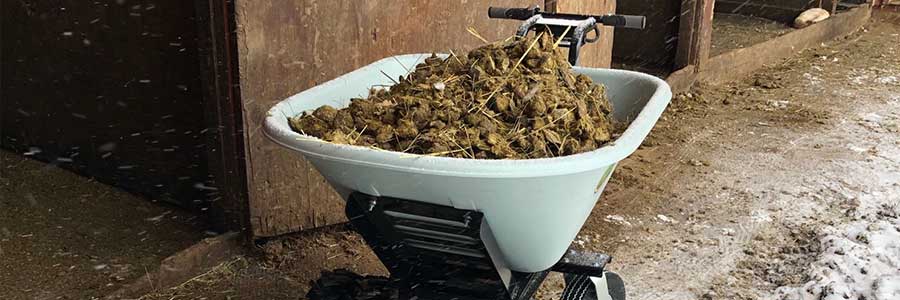
2. Air Quality & Ventilation
The ventilation in horse barns is critical for your horse health. There are a couple of different ways you can provide your barn with an adequate amount of ventilation. You can offer natural ventilation through windows in your horse's stall. Utilizing different horse stall options (grilled doors, partitions, windows, etc.) can also help you achieve better airflow. Seal up drafty areas, but don't prohibit ventilation. Remember, barns and stalls should have adequate ventilation during all months, without drafts.
Potential hazards to keep an eye on:
- Cobwebs – In the summertime, they are great with controlling pesky flies and other insects, but in the winter they can become dry, dusty fire hazards! They can be overwhelming, yes, but let's not forget how important it is to keep them to a minimum. Cobwebs catch bits of hay, bedding, and dust – all of which are extremely flammable. It should go without saying, all fire extinguishers need to be checked and fresh batteries installed in smoke detectors.
- Dust & Debris – A dust-free barn is better for both you and your horse's health. Using a broom works, but if you're looking for improved results, covering the broom with an old cloth will further collect unwanted cobwebs and dust. Another option is dusters, which can be purchased with handles that extend allowing you to reach up into your rafters and tops of your stalls. Indoor riding arenas will also see more usage in the winter. If your barn has an indoor arena, make sure the footing has been worked/leveled and add or replace as necessary. A wise investment would be to consider using a dust-down product like Moisture Lok arena conditioner to help prevent respiratory problems for you and your horse. Dust can make it hard to breathe for both the horse and rider; it irritates the eyes and lungs. Less dust worked up means less time waiting for the dust to settle… and more #TimeToRide.
- Horse Waste – Mucking your stalls regularly will keep ammonia build-up at bay. Your horse's level of comfort is defined by all its senses, including the sense of smell. Ammonia build-up will become more noticeable when the barn is closed up to keep out the cold. Some less-motivated horse owners might buy into the myth that horses like to lay in their manure because it helps keep them warm. This is simply not true and is a poor justification for not cleaning stalls. Given the choice, horses will lie down in a clean area; just watch where they rest when they're outside. What's more, manure will freeze into rock-hard balls that surely cannot be comfortable to lie on. A clean stall is not only healthier, but is also more comfortable. There are good commercial stall-dry products that can help when cleaning wet spots. Lime can be used, but there are much less toxic products on the market today that are also easier to work with; check with a local feed store to see what they carry.
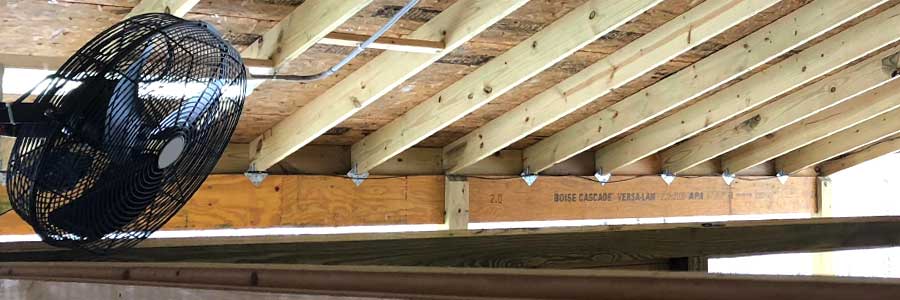
3. Barn Flooring
- Aisles – No matter how wide your barn aisle or walkway is, it's important to keep them free from rakes, pickers, and small items such as brushes, buckets, and lead ropes. Be sure that your aisle has some kind of traction so that horses don't slip from wet or snowy hooves. Stock up on salt that you can use to keep paths around the barn ice-free. If you have a concrete aisle, consider using a concrete sealant mixed with grit to help provide a rougher surface. Natural dirt floors are easy for horses to walk on, however, they can become dusty; consider using interlocking rubber pavers or mats. Both options keep the surface level, have a non-skid surface, and they reduce dust.
- Stalls – If you feel that it’s time to look at a better way to keep your stalls in shape, adding stall mats or a ThuroBed mattress system can have a positive impact on your horse. Some of the benefits include using less bedding and keeping a level surface - allowing for easier, more efficient cleaning. Horses will no longer be able to 'circle' their bedding and hay into a dirt floor, which means you no longer have to take the base of your stall out with the old bedding when you clean. These products greatly reduce the time and energy spent on maintenance.
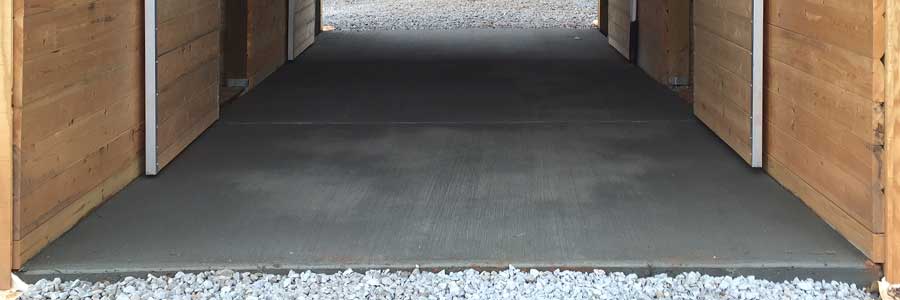
4. Water Sources
We all know that water is very important for our horses at any time of the year and especially in cold months. Horses need to keep their water intake up in the winter, just like in the summer so be sure your horses have a reliable water source that does not freeze. The average horse drinks about 10-12 gallons of water per day, and even more when the weather is hot (20-25 gallons). Water not only hydrates, but also helps to keep horses warm in colder weather. When horses cannot get enough water or only have extremely cold water, they tend to drink and eat less, which can lead to dehydration and/or colic. To avoid any problems from inadequate water supplies, make sure your water sources are well insulated in cold weather.
For example, when water drains from the hydrant and settles around the base it freezes quickly. As you turn off your hydrant be sure that the dripping water does not accumulate at ground level around the base of your water source, which can cause freezing. Hydrants can be insulated by making a simple wood box that sits on the ground or floor level and then fill it with straw or insulation at the base of the hydrant at ground level (a safer alternative to heat tape).
Automatic heated waterers, insulated buckets, and drinking post waterers allow you to avoid the tedious job of breaking the ice:
- Automatic Heated Waterers – If you use automatic waterers, it's time to hook up and test the heating elements. Pull out the heated water buckets and tank heaters, checking to make sure that all cores are still in good shape. Fill the basins of the waterers and put some water in your buckets and tanks, then test with your finger to make sure you are not getting an electrical shock. It may be more annoying than painful, but it could still deter a horse from drinking. If you're planning on installing automatic heated waters, install the water lines run and individual waterers in horse stalls. Be sure to make waterers low enough horses don't have trouble drinking from them, but high enough hay and dirt won't easily get in - generally a little below shoulder height works well. Smaller animals or ponies need lower access.
- Insulated Bucket Holders – Warmed water is more inviting than cold water, but if it's not possible to give warm water, then make sure that ice is broken regularly so your horse can get to the water. Insulated bucket holders work great if you don't have access to electricity in the barn. They help to keep heavy ice formation at bay. By filling buckets twice a day, the labor associated with breaking thick ice from buckets is helped immensely. The use of the bucket 'floater' that lays on top of the water does not seem to be an issue with horse water consumption. Black rubber buckets are a good option for watering in the winter, as they are less likely to crack than plastic buckets if you need to give them a good ''whack'' to break the ice. Setting black rubber buckets where they are exposed to the sun helps thaw the ice as the black absorbs the heat more readily. Make sure to have a couple of spare buckets so that while one set is thawing, the other set will have fresh water.
- Pasture Waterers – If your horses are in a pasture often, be sure to consider a drinking post waterer is made for outdoor pasture use, designed to keep water 50°F year-round. Pre-plan and be sure it's situated in a place that horses can congregate easily. Since areas like this get so much wear, rubber wash mats around a waterer can help to keep the dirt around it firm and in place. Avoid allowing horses access to ponds, creeks, etc. that freeze and will not hold the horse's weight. In regions with a winter climate, all outdoor waterers and troughs should be equipped with heaters or insulation and it’s smart to drain hoses after every use.
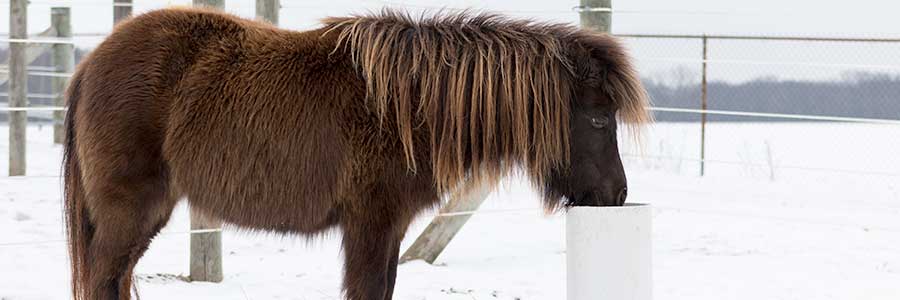
5. Efficient Barn Lighting
During the winter months, it gets dark out earlier making your barn lighting even more important because you never know when you might need to be at the barn after dark. Lighting is crucial to your vision when cleaning, feeding, and checking of your horse. Provide light in or beside each stall, in feeding areas, and outside of any entry areas. This will help you, or anyone else who helps with your barn.
- Maintenance Check – Check the lighting in the aisles and stalls to make sure everything is in good working order. If your lights need to be cleaned from cobwebs and bugs, remove light covers, replace any non-working bulbs, and wash your fixtures.
- Improvements – There are also sealed lights available designed to eliminate the chore of cleaning near the high, hard-to-reach ceilings. If the lighting itself could use some improvement, daylight LED lighting fixtures can be bright without a heavy glare.
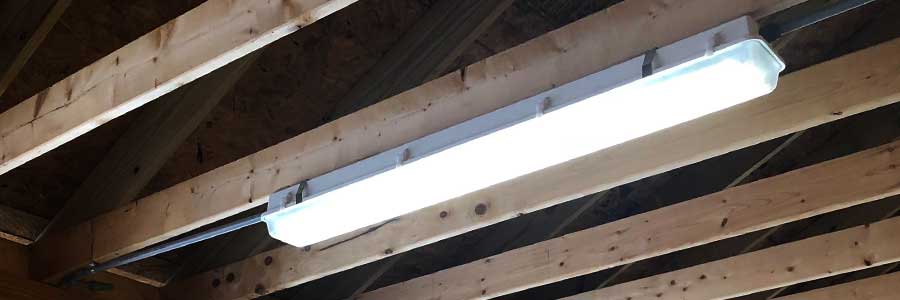
6. Tack Hacks
The winter months can be chilly so being able to get your horse tacked quickly and easily can be a big help. If horses are sensitive, have been under lights, have been body clipped, or the cold is extreme, make sure you have clean, well-fitting blankets.
- Blanket Bars – If your tack room is not heated, be extra careful when tacking up. That saddle blanket can be c-c-c-cold! After a good ride on a cold day, your horse may become hot and need to be cooled off before being turned out or put in his stall. Using a cooler helps to wick moisture to the wool cooler top keeping your horse drier. The cooler will also keep your horse warm until dry. Once you are done with the cooler, what do you do with it? Adding blanket bars on the front of each stall or in a convenient place in your barn will allow your cooler and blankets to hang and dry easily. Some blanket holders lock outwards, away from the stall door for more room and ventilation. If you have several horses in your barn, blanket bars help keep each horse's blanket ready for a quick turnout.
- Collapsible Saddle Rack – Have your saddle and bridle readily available so once your horse is groomed and ready to saddle. It's so convenient to reach behind you and pick up your saddle with its pad and put it right on your horse's back. When it’s not being used, it can be shifted downwards to hang flush against the wall. Alternatively, a homemade saddle rack can be made with the length of wood, approximately 14" long by 2" wide using a large eye screw that hangs on a hook on your stall wall.
- Rodent Control – If your tack room is heated, it becomes more inviting to rodents who are looking for a winter home. Be careful in your choice of rodent control; a poisoned rodent can crawl off and die in an inaccessible place and cause a really horrible smell. Traps can catch fingers and the barn dog's nose. Humane, non-offensive rodent control is a sign of a well-managed barn.
- Tack Storage – Having your stall cleaning tools in one convenient place saves time, rather than having to go from one end of your barn to the other to find things. Find a good corner or wall where you can hang tools and always return them to that place after each use. Hang lead ropes and halters on each horse's door or you can purchase a row of hooks that hang over your stalls front partition for quick and easy access. Keep brushes in tack boxes or brush boxes that are out of the way of your horse's path.
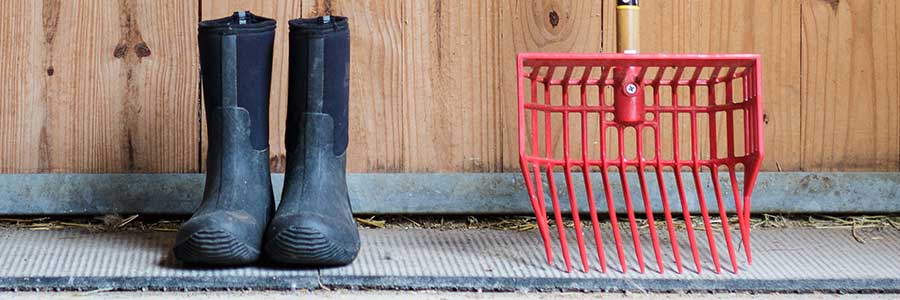
7. Horse Nutrition & Wellbeing
Be sure to check for snow build up in your horses' hooves. Packing snow will accumulate quickly and form a "snowball" in your horses' hooves making it very hard for them to walk. This is not only uncomfortable, but can cause a horse to lose traction and possibly slip. Avoid chances of pulled tendons or lameness by checking hooves daily. You can use Vaseline on the inside of the hoof and the snow will slip off.
- Nutrition – If you store any liquid medications or supplements in your barn, move them to a heated area for the winter. Stock up on feed and shavings in case you get snowed in. One or two freezes can cut the nutrition from grass that your horses have feasted on during summer. It’s important to remember to watch for any signs of weight drops at this time of the year and regulate your horse's amount of hay. If you feed your horse outside, be sure to supplement with enough hay so that your horses can 'graze' with the hay that you provide. If your pastures are turning to dirt, it is very important to be sure that you provide enough roughage, such as grass hay, to keep them 'busy'. Bored horses tend to pick up more dirt from foraging that can lead to colic. Consider using a round-bale feeder or feeding hay for pastures still in use to help fight boredom and provide necessary grazing. It's also important to review how much grain your horse is getting in cold weather. If temperatures drop, grain has a good source of nutrients that will give your horse a boost of energy and warmth. Corn can also be added to feed in cold weather to add warmth.
- Mineral Salt Blocks – Your horses instinctively crave minerals and salt when their diet lacks it. Salt will help to keep horses hydrated with an ample water supply and the minerals will support good body functions. Local farm stores and granaries carry blocks and as always, consult your veterinarian about any questions you have regarding winter care.
- Pasture Protection – Horses can handle quite cold temperatures if they have a good thick coat and keep dry. However, there are many times when your horses will need to get out of the wind and inclement weather. Provide a place where they can get into a sheltered area such as a three-sided shelter, horse stall, or an enclosed area. Be particularly watchful with older horses that may need additional care or even blanketing, as well as younger yearlings or foals. Periodically check your horses throughout the day when temperatures plummet. If you notice shaking, rolling, or a non-responsive attitude - call your vet. When temperatures and snow don't allow you the ability to turn out your horses daily, be sure to find a way to walk them, or at least have a small area where they can get some exercise to help them keep good circulation in the cold weather. Make sure pastures and grounds are debris-free so there is not a hidden, looming danger underneath the first heavy snowfall.
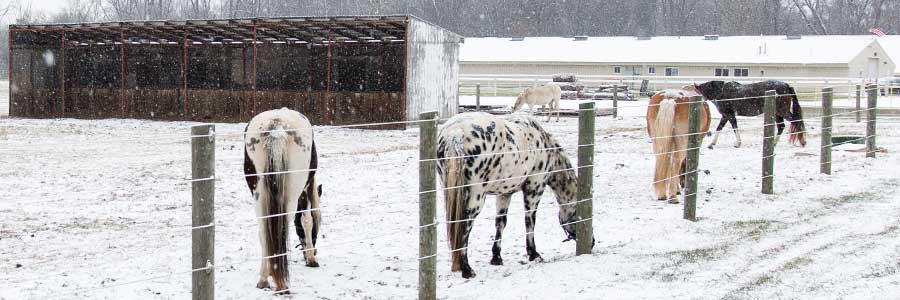
8. Personal Tips
Take stock of all your winter gear and ensure it's laundered and in good shape. It's beneficial to stock up on some hand warmers for extra-cold days. Hand warmers are small pouches that are activated upon opening and stay warm for hours. They are inexpensive and can also be used in shoes to keep your feet and toes warm. Be sure to keep a few in your trailer or truck for emergencies. Cold winter air also dries out skin and chaps lips; keep high-quality lotion and chapstick handy!
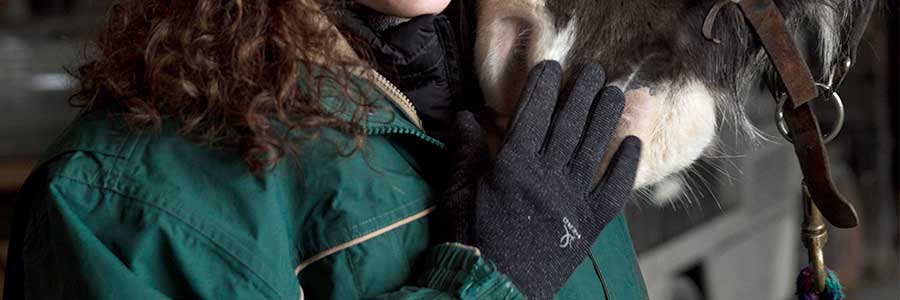
RAMM Tip: It's best to winterize your barn when the weather is still reasonably warm; you'll be able to get your pre-winter barn inspection done in no time. Repairs can be made without the bulkiness of winter coats and gloves. This way your horse will have a safer, healthier, and more comfortable environment in the winter.